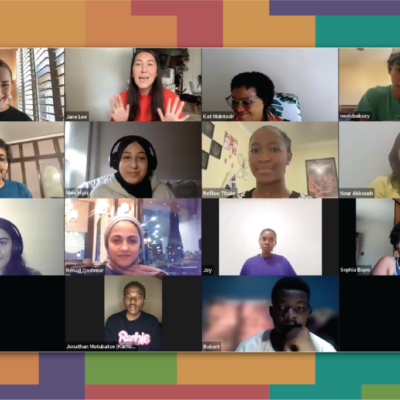
An Interview with Kinful: Bringing Cross-Cultural Empathy to Schools with VR
How do we prepare today's students to thrive in an uncertain world? One proven technique is for schools to wholeheartedly support students' social and emotional development — their empathy, their ability to bounce back after failure, and their capacity to connect meaningfully and sensitively with diverse people across the world. Schools are demanding effective social and emotional learning (SEL) approaches now more than ever, and Michael Auerbach and Sam Williamson, co-founders of Kinful, are two of the visionaries rising to meet the need.
The Kinful curriculum is designed to build five key social and emotional skills in students from elementary through high school. Among SEL programs, one really unique thing about Kinful is that it leverages the power of virtual reality (VR) to empower students to connect in meaningful and empathy-building ways across geographical boundaries.
Students in Kinful classrooms — so far in New Jersey, New York, Texas, Washington, South Africa, Turkey, and soon the Ukraine — create 360-degree videos to share their daily activities, interests, thoughts, and feelings with peers across the country and the world. iThrive caught up with the Kinful team to find out more about their inspiration, their successes and obstacles, and their hopes for the future of the program.

Students using Kinful's VR headsets react to 360-degree videos created by students from another country. Image source
iThrive: You have shared that Kinful's mission was inspired by your Peace Corps service. From there, how did you decide to use VR in schools to support cross-cultural empathy?
Kinful: Peace Corps exemplifies a powerful aspect of humanity: the innate ability of humans to empathetically connect with one another despite vastly different cultural backgrounds. Peace Corps volunteers and host-country nationals instinctively laughing together, crying together, and caring for one another highlights how empathy can transcend cultural boundaries. The idea that empathy is the thread that binds humanity together is a central inspiration for Kinful.
We knew we needed active engagement, as opposed to passive engagement like watching a documentary, in order to recreate the Peace Corps experience in the classroom. The immersive aspect of VR provides the exact type of active engagement needed!
iThrive: What are the key components of the Kinful curriculum?
Kinful: A typical Kinful lesson consists of non-sequential workstations where students rotate between activities. Half of the workstations are VR-related (viewing and filming), and half are "standard" SEL activities (e.g., teamwork games, group reflections, etc.).The VR and the 360 filming activities within that rotation are fundamental to Kinful's vision and impact, but they make up only a portion of the greater Kinful whole. The tech and non-tech activities support and extend each other. As students move from one workstation to the next, they experience and reflect on SEL themes individually, in groups, and through someone else's eyes (VR).
The Kinful kit comes with a range of engaging materials — including VR headsets — teachers can use to support students in building 5 key social and emotional skills. Image source
iThrive: What is it like when a student first connects with a peer from another place and way of life? What emotions do you see being shared, and what kinds of stories?
Kinful: It's all smiles when a student puts on a headset — but to be honest it's hard to tell if the smile is coming from the inherent delight in identifying with someone else in a different country, or if it's coming from the awe of using VR presumably for the first time. It's probably a little bit both, which is fine with us!
iThrive: What about after the connection — what do you see or hear from students? How do they talk about the experience?
Kinful: In an effort to get students to relate to one another, we always prompt students to share videos of universal experiences like spending time with family/friends or taking care of responsibilities. Of course, these things will look different across cultures, but the general concept is always recognizable and relatable.
From there, students usually come out of a Kinful video saying something like, "I eat lunch with my friends too!" or "I also have to do house chores after school!" These simple and universally translatable experiences help bridge cultures — moving us away from a more removed, academic understanding (fun facts of a foreign country) and getting us closer to a more personable familiarity ("Mohammed from Senegal loves walking his dog in the morning. So do I!").
iThrive: What has surprised you most about what students want to share with each other through the videos they create?
Kinful: What they want to share hasn't been particularly surprising (again, our prompts revolve around everyday stuff), but how they've been sharing has been surprising. By that, I mean their eagerness! I anticipated awkward hesitation in our students' first videos (probably because I could easily imagine my twelve-year-old self awkwardly talking about my Warren G CD or Green Day blacklight poster). But no — teachers tell us their students love filming themselves!
A student uses a head-mounted camera to create 360-degree video for Kinful peers around the world. Image source
iThrive: What's your biggest (or favorite) success story to date?
Kinful: Our biggest success story to date has been our adoption of "standalone" VR headsets, which are headsets with an operating system and screen built in. Prior to this adoption, we used a smartphone + headset setup to view VR videos through a Kinful app, which involved two central hurdles: 1) procuring a smartphone and 2) Wi-Fi connection to stream videos.
Standalone headsets solve these two hurdles because: 1) the price of a standalone headset is a fraction of the cost of a smartphone and 2) standalone headsets allow us to upload our entire VR library onto the device, bypassing the need for Wi-Fi to stream (smartphones typically don't have the capacity to store our library).
iThrive: What are some of the obstacles to extending the reach of a program like Kinful into poor and rural areas across the globe? What are some solutions you are using or planning to use?
Kinful: The biggest obstacle was internet access needed to view our VR videos. Our recent adoption of standalone headsets with our VR library preloaded has solved this problem. Now, we're able to send a Kinful kit to a partner site with everything needed to execute Kinful programming (VR hardware, activity supplies, etc.).

A student donning the Kinful VR headset. Image source
iThrive: What advice would you give a developer who wants to design tech- or game-based experiences that promote or support empathy?
Kinful: Our mission is to encourage students come to their own conclusion that what binds humanity together is greater than what divides us. We want students to watch these videos and notice the similarities they have with students from all over the world. Once those connections start being made, empathy naturally follows. That's why we've stocked the Kinful video library with universal, relatable experiences.
In that vein, we've thus far shied away from creating traumatic reenactments to promote empathy, like first-person angles of bullying for example. That's not to suggest we believe such a video would be ineffective — it's just that we've found students to be more open and vulnerable when engaging with less threatening material.
iThrive: It's no secret that it can be really challenging to get both SEL and tech-based programs adopted and implemented widely in schools. What obstacles have you faced and how do you get around them?
Kinful: The biggest challenge has been schools figuring out how to pay [for Kinful]. Most schools we've talked to don't have an SEL budget, but they do have a tech budget. Problem is, Kinful doesn't neatly fit into a tech category since we're not targeting tech outcomes. With our main focus being SEL, we've had the most success engaging with schools that already have SEL initiatives taking place.
iThrive: What advice would you give to a teacher who is uncomfortable using technology in the classroom? What about teachers who struggle with teaching SEL?
Kinful: The first bit of advice for a teacher uncomfortable with using technology or integrating SEL would be that there's no need to reinvent the wheel! There are a lot of high-quality resources out there that present best practices, materials, and tutorials for both.
We definitely wanted to try and get out in front of any potential unfamiliarity with tech or SEL by creating a curriculum that is largely student led. Teachers who are uncomfortable with tech and SEL have in Kinful a simple yet high-quality way to get started without the pressure of creating their own programming. With all materials and directions supplied, the teacher just stages the room and follows the steps to facilitate the lesson. We designed Kinful to be as useful to a savvy veteran teacher as it would an inexperienced summer camp counselor.
iThrive: What's your vision for what's happening at Kinful in 5 years?
Kinful: Kinful is ultimately building towards creating a global community of schools, an international network of students and educators discovering connections and growing together towards a more empathetic future.
However, as we've designed Kinful to be molded by students (prompts are open-ended, and we encourage students to film and share what matters most to them), we imagine that as the years pass they will change and shape the program, bringing us to a place we had never even imagined!
__________
To learn more about the Kinful curriculum, visit www.kinful.org and check out the team's orientation video for partner schools:



